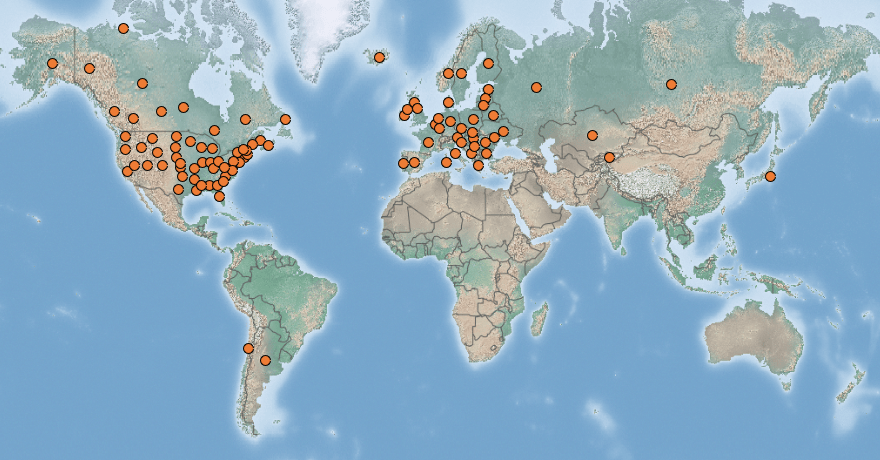 |
American mink | Status LU: absent. |
 |
Amerikaneschen Näerz1 | Status Eur.: established. |
 |
Vison d’Amérique | RA: ISEIA: A0, Alert List. Harmonia+: 0,21 |
 |
Amerikanischer Nerz, Mink | Wikipedia: |
 |
Amerikaanse nerts | Back to the list of vertebrates |
Contents
Report the species
→ Report Neovison vison to the National Museum of Natural History.
Brief description
In both its native and introduced ranges, Neovison vison (Schreber, 1777) is commonly found on brook and riverbanks with dense vegetation, damp forests, reed beds and marshes. Individuals escaping from fur farms have established feral populations in many European countries. Whereas this species has already been observed in the wild several times in Belgium, it has not been reported to have developed viable populations so far. M. vison may severely reduce prey populations (salmonids, amphibians, waterfowl, rodents, etc.) and is a serious threat for red-listed ground-nesting birds. It is also suspected of displacing its relative, the European mink Mustela lutreola, and the European polecat Mustela putorius (Branquart et al. 2013).The European mink became endangered in the 20th Century, as a result of hunting for the fur trade, habitat loss and invasive alien species, especially the American mink (Wikipedia contributors 2020).
Controversy on listing as IAS of Union concern
The American mink has been the subject of intense discussion, both within the EU Scientific Forum on IAS and the EU Committee on IAS, opposing Northern European countries where breeding for the fur trade is practised versus other EU member countries concerned by the impacts of the invasive species. Scientific reports (e.g. Roy 2017) and publications have emerged from this controversy. Some stakeholders expressed their consternation that the American mink has not been included in the list (e.g. Swabe 2019).
Status and distribution in Luxembourg
The first documented occurrence of Neovison vison (Schreber, 1777) in Luxembourg dates from March 1993, when a mink was caught in a trap by a hunter in the vicinity of the village of Manternach (Municipality of Manternach). A second record dates back to 2013 (Schley & Herr 2019: 62), when the carcass of a sick animal was found in a forest near Esch-sur-Alzette and sent to the Nature and Forest Administration (Schley 2020).
It is not known whether there is an established population of American mink in Luxembourg (Schley 2001).
There is no distribution map available because no data has been entered into the Recorder-Lux database so far (MNHNL, iNaturalist & GBIF 2019).
Risk assessment
ISEIA protocol
A0 (3+3+3+2) = Alert List (Ries et al. 2014: 199).
Harmonia+ protocol
Overall risk score 0,21 = (Overall Invasion score 0,54 x Overall Impact score 0,39) (evaluated by Sandra Cellina, Jan Herr and Manou Pfeiffenschneider).
 Invasion
Invasion0,39

 Impact
Impact0,21

 Risk
RiskWorldwide distribution
Bibliography
- Branquart, E., M. D’aes, B. Manet, G. Motte, V. Schockert, J. Stuyck & K. Van Den Berge, 2013. Harmonia database: Mustela vison (Schreber, 1777). Harmonia version 1.2, Belgian Forum on Invasive Species. URL: http://ias.biodiversity.be [accessed on 2019-10-24]
- CABI, 2014. Neovison vison (Schreber, 1777) [text by ISSG, update by Santiago Palazón]. In: Invasive Species Compendium. Wallingford, UK: CAB International. URL: www.cabi.org/isc [accessed 2020-02-04]
- MNHNL, iNaturalist & GBIF, 2019. MNHNL-mdata, online portal combining species observation from Recorder-Lux, iNaturalist and GBIF. National Museum of Natural History, Luxembourg. URL: https://mdata.mnhn.lu [Accessed 2019-10-24]
- Naturverwaltung (ed.), 2013. Jagbare Wildtierarten Luxemburgs. 96 pp.
- Pir, J.B. & L. Schley, 2015. Développement des connaissances sur la répartition et l’écologie des mammifères au Luxembourg entre 1990 et 2015. Bull. Soc. Nat. luxemb. 116: 437-455.
- Ries, C., M. Pfeiffenschneider, Engel, E., J.-C. Heidt & M. Lauff, 2014. Environmental impact assessment and black, watch and alert list classification after the ISEIA Protocol of vertebrates in Luxembourg. Bull. Soc. Nat. luxemb. 115: 195-201. [PDF 247 KB]
- Roy, S. 2017. Information on measures and related costs in relation to species considered for inclusion on the Union list: Neovison vison. Technical note prepared by IUCN for the European Commission.
- Schley, L., 2001. First Record of the American Mink Mustela vison (Mammalia, Mustelidae) in Luxembourg. Bull. Soc. Nat. luxemb. 102: 45-48. [PDF 215 Kb]
- Schley, L., 2020. Personal communication by phone to C. Ries on 2020-02-04.
- Schley, L., C. Schanck, M. Schaul & C. Sinner, 2001. Neubürger und Heimkehrer unter den Wildtieren Luxemburgs. Beiträge zur Jagd- und Wildforschung 26: 141-154.
- Schley, L. & J. Herr, 2019. Säugetiere Luxemburgs. Hrsg.: natur&ëmwelt a.s.b.l., Ministère du développement durable et des infrastructures, Administration de la nature et des forêts. 219 S. ISBN 978-2-9199511-0-9 [French edition: Les mammifères du Luxembourg, ISBN 978-2-9199511-2-3]
- Swabe, J. 2019. Feedback from: Humane Society International/Europe (Netherlands) on the Updated list of invasive non-native species in the EU. Feedback reference F461527. URL: https://ec.europa.eu/info/law/better-regulation/initiatives/ares-2019-1565888/feedback/F461527_en?p_id=4101650
- Wikipedia contributors, 2020. ‘European mink’, Wikipedia, The Free Encyclopedia. URL: https://en.wikipedia.org/wiki/European_mink#Competition_with_the_American_Mink_and_disease [accessed 2020-02-05]
Suggested citation of this webpage
Ries, C. & M. Pfeiffenschneider (Eds.), 2025. Neovison vison (Schreber, 1777). In: neobiota.lu - Invasive Alien Species in Luxembourg. National Museum of Natural History, Luxembourg. URL: https://neobiota.lu/neovison-vison/ [Accessed 2025-12-31].
Page content last updated on 2024-03-13. Last proofread by Caroline Grounds on 2019-11-28.



